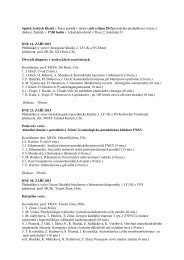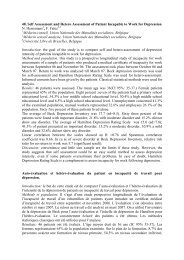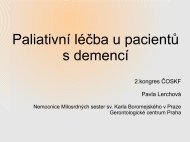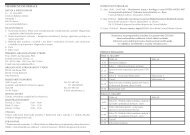ABSTRACTS â ORAL PRESENTATIONS - AMCA, spol. s r.o.
ABSTRACTS â ORAL PRESENTATIONS - AMCA, spol. s r.o.
ABSTRACTS â ORAL PRESENTATIONS - AMCA, spol. s r.o.
Create successful ePaper yourself
Turn your PDF publications into a flip-book with our unique Google optimized e-Paper software.
in MEF cells reveals requirement of the interaction between AMER1 and β-arrestin for<br />
Wnt3a-induced AMER1 dynamics. (A-C) WT and β-arr1/2 DKO MEFs were transfected<br />
with EGFP-AMER1 (A, B) or EGFP-AMER1(2-838) (C) and membrane dynamics of the<br />
constructs was analyzed by Fluorescence Recovery After Photobleaching (FRAP) method.<br />
Example of cells subjected to FRAP is given on the left, squares indicate bleached regions.<br />
On the right statistical analysis of FRAP experiment using WT and β-arr1/2 DKO MEFs<br />
stimulated with PBS or Wnt3a is shown. The graphs show mean values + s.e.m., and<br />
the best fitting curve model, which was used for calculation of mobile pool of EGFP-<br />
AMER1 (% of fluorescence recovered) and of the recovery halftime (T1/2). N – number<br />
of analyzed cells.<br />
P25. DETECTION OF CANCER STEM CELL MARKERS AND ANALYSIS OF EPITHELIAL-TO-<br />
MESENCHYMAL TRANSITION IN PROSTATE BENIGN AND CANCER CELL LINES<br />
Eva Sedlmaierová 1,2* , Zuzana Pernicová 1,3 , Šárka Šimečková 1,2 , Eva Slabáková 1,3 , Radek<br />
Fedr 1 , Alois Kozubík 1,2 , Karel Souček 1,3*<br />
1<br />
Department of Cytokinetics, Institute of Biophysics, Academy of Sciences of the Czech<br />
Republic, Brno, Czech Republic;<br />
2<br />
Department of Experimental Biology, Faculty of Science, Masaryk University, Brno,<br />
Czech Republic;<br />
3<br />
Center of Biomolecular and Cellular Engineering, International Clinical Research Center,<br />
St. Anne´s University Hospital Brno, Brno, Czech Republic<br />
*Correspondence to: sedlmaierova@ibp.cz, ksoucek@ibp.cz<br />
Cancer stem cells (CSCs) have long been implicated in numerous tumour formations<br />
and therapy resistance including prostate cancer disease. Importantly, mechanisms of<br />
their origin have not been elucidated in prostate cancer yet. It has been demonstrated<br />
that epithelial-to-mesenchymal transition (EMT) is phenomenon which can lead to the<br />
acquisition of stem cell properties in various types of cancer. This was first discovered<br />
by research on immortalized human mammary epithelial cells, where induction of EMT<br />
resulted in the acquisition of mesenchymal properties and in the expression of stem<br />
cell markers. Furthermore those cells had properties similar to mammary epithelial<br />
stem cells (Mani et al., 2008). In prostate cancer, cells with EMT phenotype have been<br />
shown to express stemness factors and to have increased clonogenic capacity (Kong et<br />
al., 2010). However phenotypic heterogeneity and EMT status of routinely cultivated<br />
prostate cell lines remains unknown.<br />
In this study we aimed to screen surface expression of selected CSCs markers (Trop2,<br />
CD133, CD44, CD24 and CD49f) in a panel of prostate benign and cancer cell lines using<br />
multicolour flow cytometry. We found out that each cell line express different set and<br />
combinations of these CSCs markers. Next, to elucidate the EMT status in putative<br />
CSCs subpopulations, we combined analysis of selected surface stem cell markers with<br />
detection of regulators and markers of EMT (Snail, Slug, E-cadherin, N-cadherin) in<br />
CD24/CD44 subpopulation of PC-3 and DU-145 cells.<br />
Analytical Cytometry VII 117








